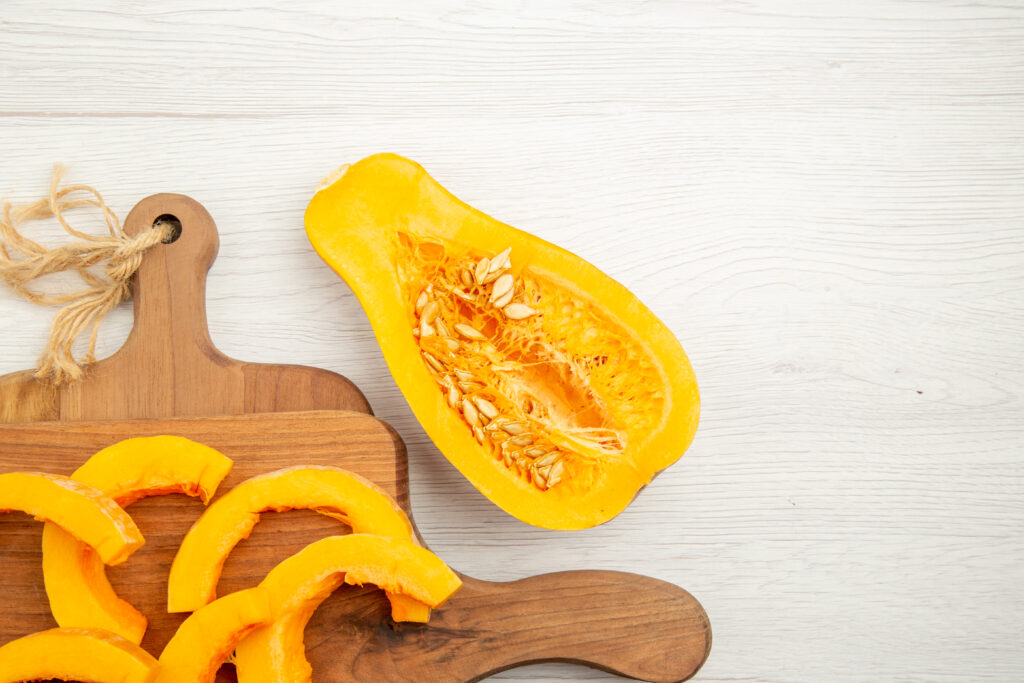
If your only experience with winter squash consists of Grandma’s butternut squash casserole at holiday meals, you’re missing out. Not only is there a big wide world of winter squash out there, but most varieties are available now. If you need more encouragement, it’s National Fruit and Veggies Month, when we’re inspired to eat all kinds of produce. Here’s what you need to know to best enjoy the healthy, versatile category of veggies known as winter squash.
What are winter squash
Winter squash are grown during the summer, and get their name because they’re eaten throughout the fall and winter months. . They are harvested when fully mature, with tough exteriors and a lower moisture content than summer squash, like zucchini. (In contrast, summer squash are meant to be consumed when they are young, small, and tender.) Some of the most popular winter squash are butternut, acorn, pumpkin, and spaghetti squash.
How to store winter squash
If you grow your own winter squash, proper storage is important in order to keep them for multiple months. (I recently ate a spaghetti squash harvested from my garden last October—amazing how good it still was!) And if you don’t grow your own, you’ll find many varieties of winter squash at farmers markets and supermarkets. No matter where your winter squash comes from, make sure they’re in good condition. Look out for blemishes, cuts, or soft spots, as they can cause the squash to spoil. You’ll also want to store your squash in a cool, ventilated place. Keep them away from apples, pears, or other ripening fruit, as they produce a gas that speeds up decay.
What’s great about winter squash nutritionally?
Many winter squash varieties have orange or yellow flesh. This means that they’re a good source of carotenoids, some of which our bodies convert to vitamin A. (Learn more about that in this blog post.) They are also a good source of fiber and rich in potassium, a mineral lacking in many diets.
Despite being considered a starchy vegetable, winter squash are lower in carbohydrates and calories than sweet or regular potatoes. Not surprisingly, they’re higher in carbohydrates and calories than non-starchy veggies—leafy greens, cucumbers, and Brussels sprouts, for example. But this doesn’t mean you should cross them off your list! Overall, they are healthy veggies that are certainly worth incorporating into your seasonal diet. As a rule of thumb, aim for winter squash to occupy about 25% of your plate’s real estate.
How to use winter squash
Winter squash is typically cooked by steaming, baking, or microwaving, and often prior to being used in a recipe. Before cooking, always wash the outside of the squash to remove dirt and bacteria. And when you’re ready to cook, consider some of these ideas:
Soup and stew
Squash soup is endlessly customizable and simple to prepare. Winter squash ares often pureed, such as in this Thai Butternut Squash Soup. They can also be thickened with rice, potato, or cream. This technique leads to a smooth and comforting dish, like this Curried Squash and Apple Bisque. Or try cubing your squash for a hearty addition to stews and chili, like this Slow Cooker Lentil Chili. This method is easy and delicious as well!
Casseroles and side dishes
Butternut squash is a favorite for holiday casseroles (our version features Parmesan and breadcrumbs instead of a sweet topping). But other types of winter squash, such as hubbard or kabocha, can be substituted with equally tasty results. Try a simple Winter Squash Gratin with your choice of squash, or a squash risotto like this one. For a sweeter side dish, try this Citrus Roasted Squash and Sweet Potatoes—perfect for holiday time or, really, any time.
Skillet meals
I adore skillet meals not only for their taste, but because they are easy and family-friendly. You can usually find pre-peeled and cubed butternut squash in the produce section. Especially on a busy weeknight, that can make meals like this Beef, Squash and Couscous Skillet much simpler and quicker to prepare. And while not exactly a true skillet meal, this Winter Squash and Kale Risotto cooks in just one pan. For a more substantial dish, add a little bit of leftover sausage, tofu, chicken, or pork.
Pasta
Using squash in pasta dishes may not be the first thing you think of with winter squash. But you might be surprised how well the two go together. You can layer squash in a lasagna, like in this Squash and Leek Lasagna. Or combine squash and your favorite pasta shape, like in our Baked Roasted Squash, Ricotta and Pasta bake.
Stuffed
Stuffed acorn squash always makes a beautiful dish. Whether as a main course or a side dish, there are so many options. Holiday meals, dinner parties, or an ordinary Wednesday night—we’ve got recipes for them all! Here are three you might like to try as we start another delicious season of winter squash: